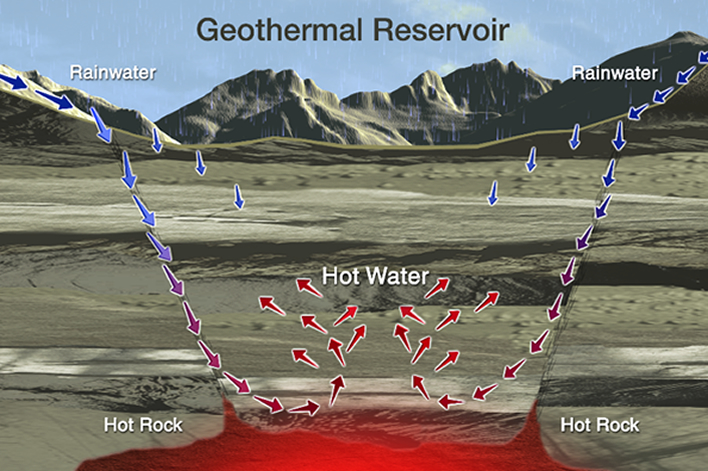Geothermal Revolution: How Enhanced Systems Are Powering Our Clean Energy Future
Harnessing the Earth’s vast subsurface heat has the potential to revolutionize global energy systems. Enhanced Geothermal Systems (EGS), once a niche scientific pursuit, now promise to deliver limitless, 24/7 clean power by leveraging advanced drilling technologies and repurposing fossil fuel expertise. This transformation represents one of the most significant opportunities in the clean energy transition, offering a solution that could provide reliable, baseload power while dramatically reducing carbon emissions.
The Unprecedented Potential of Subsurface Energy
Understanding Earth’s Heat Engine
The Earth continuously radiates approximately 47 terawatts of heat—an amount equivalent to the output of 100,000 nuclear power plants operating simultaneously. This heat originates from two primary sources: radioactive decay of elements within the Earth’s core and residual heat from the planet’s formation billions of years ago. Unlike solar or wind energy, which depend on weather conditions and time of day, this geothermal energy is constant and available around the clock.
However, traditional geothermal systems—which rely on naturally occurring hydrothermal reservoirs—tap into less than 0.1% of this resource. These conventional systems require specific geological conditions: naturally occurring hot water or steam trapped in porous rock formations, typically found in volcanic regions such as Iceland, California’s Geysers, or the Philippines. This geographic limitation has historically restricted geothermal development to specific regions, leaving vast areas without access to this renewable resource.
Breaking Geographic Barriers with Enhanced Geothermal Systems
Enhanced Geothermal Systems (EGS) overcome this fundamental constraint by creating artificial reservoirs in hot, dry rock formations that are widespread at depth across the globe. The process involves drilling deep into the Earth’s crust where temperatures are sufficiently high, then using hydraulic fracturing techniques to create a network of cracks in the otherwise impermeable rock. This engineered reservoir allows water to circulate through the hot rock, absorbing heat before returning to the surface to generate electricity.
This technological breakthrough means that regions previously considered unsuitable for geothermal energy—such as much of the eastern United States, large parts of Europe, and many developing nations—can now potentially access clean, renewable geothermal power. The implications are enormous: instead of being limited to a few hundred sites worldwide, EGS could make geothermal energy available virtually anywhere with sufficient subsurface heat.
Quantifying the Opportunity
A landmark study by Princeton University forecasts that EGS could supply up to 20% of U.S. electricity by 2050—potentially generating 500 gigawatts under supportive policies. To put this in perspective, this would make EGS the third-largest clean energy source in the United States, behind only wind and solar power. The study considered various scenarios, including different levels of government support, technological advancement rates, and market conditions, consistently showing EGS as a major contributor to America’s clean energy future.
According to the International Energy Agency (IEA), next-generation geothermal technologies could theoretically meet global electricity demand over 140 times. This staggering figure reflects the vast untapped potential of the Earth’s subsurface heat. Commercial projects are expected to come online by 2026, marking the beginning of what could be a transformative decade for geothermal energy.
Engineering the Impossible: How EGS Works
Core Technological Leaps
Artificial Reservoir Creation: The Foundation of EGS
The fundamental innovation behind EGS is the ability to create artificial geothermal reservoirs where none existed naturally. This process begins with drilling operations that reach depths of 2–4 miles underground, where temperatures range from 400°F to 750°F (200°C to 400°C). At these depths, the Earth’s crust contains abundant thermal energy, but the rock is typically dry and impermeable.
The key breakthrough is using high-pressure fluid injection to fracture this impermeable rock, creating a complex network of interconnected cracks. This engineered fracture system functions as a subterranean heat exchanger. Water is then continuously circulated through these fractures: it enters the system at one well, flows through the heated rock matrix, absorbs thermal energy, and returns to the surface through a second well as superheated water or steam. This hot fluid drives turbines to generate electricity, after which it is cooled and reinjected to repeat the cycle.
This closed-loop system is remarkably efficient and sustainable. Unlike some renewable technologies that require constant fuel inputs or have significant waste streams, EGS operates on a renewable resource that will remain available for billions of years, with minimal environmental impact when properly managed.
Oil & Gas Tech Transfer: Accelerating Development
One of the most significant factors enabling the rapid advancement of EGS has been the transfer of technologies perfected in the oil and gas industry. Techniques developed for extracting shale oil and gas—such as horizontal drilling, multi-well pad operations, and advanced drill bit technologies—are now being adapted for geothermal applications.
Horizontal drilling, which allows operators to access resources over a much larger area from a single surface location, has proven particularly valuable for EGS. Multi-well pad operations enable the creation of complex fracture networks that maximize heat extraction efficiency. Perhaps most importantly, the development of synthetic diamond drill bits has dramatically reduced drilling times and costs.
This technological convergence has accelerated drilling speeds by tenfold compared to traditional geothermal methods. For example, Fervo Energy completed 3-mile-deep wells in just 16 days in Utah—a feat that would have taken months using conventional techniques. This dramatic improvement in drilling efficiency is crucial for making EGS economically viable, as drilling costs typically represent 50% or more of total project expenses.
Closed-Loop Alternatives: Addressing Environmental Concerns
While hydraulic fracturing has enabled the widespread deployment of EGS, it has also raised legitimate environmental concerns, particularly regarding induced seismicity and water usage. In response, companies like Eavor have developed closed-loop systems that avoid hydraulic fracturing altogether.
These systems use sealed underground radiators—essentially large U-shaped pipes installed deep underground. A working fluid circulates through these sealed pipes, absorbing heat from the surrounding rock through conduction rather than convection. Because no fluids are injected into the rock formation and no fractures are created, these systems eliminate the risk of induced seismicity and require virtually no water consumption.
While closed-loop systems are currently more expensive than conventional EGS approaches, they offer significant advantages for seismically sensitive regions or areas with limited water resources. They represent an important diversification of geothermal technologies, providing options that can be tailored to specific environmental and regulatory conditions.
Comparing Next-Gen Geothermal Approaches
| Technology | How It Works | Advantages | Current Cost (per MWh) |
|---|---|---|---|
| Enhanced (EGS) | Hydraulic fracturing of rock creates artificial reservoirs for heat exchange | Lowest cost pathway; leverages existing oil/gas expertise and infrastructure | $100–$240 |
| Closed-Loop (AGS) | Sealed pipes in conduction zones transfer heat without fluid injection | Minimal seismicity risk; negligible water use; suitable for sensitive environments | $105–$321 |
| Superhot Rock >375°C systems (>3.7 miles deep) | Access to supercritical fluids at extreme depths provides 10x power per well | Extremely high energy density; represents next frontier in geothermal efficiency | >$300 (R&D phase) |
Each approach offers distinct advantages and trade-offs, allowing developers to select the most appropriate technology based on local geological conditions, environmental requirements, and economic considerations.
Frontier Innovations: Pushing the Boundaries
Quaise Energy’s Millimeter Wave Drilling: Beyond Mechanical Limits
Traditional mechanical drilling faces fundamental limitations when attempting to reach the deepest, hottest regions of the Earth’s crust. Drill bits wear out, equipment fails under extreme temperatures and pressures, and progress slows dramatically at depths beyond 3-4 miles.
Quaise Energy is addressing these challenges with revolutionary millimeter wave drilling technology. This approach utilizes gyrotrons—high-powered microwave generators—to vaporize rock rather than mechanically breaking it apart. The technology can potentially access depths of 6 miles where temperatures reach 900°F (480°C), opening up entirely new resource zones.
This method promises not only to reach previously inaccessible geothermal resources but also to do so much faster than conventional drilling. Early tests suggest that millimeter wave drilling could reduce the time and cost of accessing superhot rock resources by orders of magnitude, potentially making these extreme-depth systems economically viable.
Hybrid Power Plants: Maximizing Efficiency and Flexibility
One of the most exciting developments in geothermal technology is the emergence of hybrid power plants that combine EGS with other renewable technologies. These integrated systems can achieve higher overall efficiency and provide greater grid stability than single-technology approaches.
For example, integrating EGS with solar thermal systems allows for thermal energy storage that can smooth out power delivery and provide dispatchable power during peak demand periods. Combining EGS with hydrogen combustion systems creates flexible power plants that can respond rapidly to grid needs while maintaining zero-carbon operation.
These hybrid approaches represent the future of renewable energy systems, where multiple technologies work together to provide reliable, clean power while maximizing resource utilization and economic returns.
Economics: From Niche to Mainstream
Rapid Cost Reduction Through Innovation
The economics of EGS are improving dramatically due to innovations in drilling technology and economies of scale. Learning rates—measures of how costs decrease as cumulative production increases—show that EGS is advancing faster than many other clean energy technologies.
EGS learning rates of 35% significantly outpace those for solar photovoltaics (24%) and battery storage (30%). This means that each time cumulative EGS capacity doubles, costs fall by 35%. At this rate, EGS prices could drop to $80/MWh by 2027 and $50 by 2035, making geothermal competitive with natural gas and other conventional power sources.
Corporate and Utility Adoption
Major corporations and utilities are beginning to recognize the value proposition of EGS. Google has signed agreements for 600 MW of EGS power with Fervo Energy, representing one of the largest corporate renewable energy purchases to date. Similarly, contracts with utilities like Cal Edison indicate growing industry confidence in EGS technology and economics.
These corporate commitments provide crucial validation and financial backing that will accelerate technology development and commercial deployment. They also demonstrate that major energy consumers view EGS as a reliable, long-term solution for meeting sustainability goals.
The Value of Baseload Power
Unlike intermittent renewables such as wind and solar, EGS provides firm, baseload power that operates 24/7 regardless of weather conditions. This reliability has enormous value in modern electricity grids, where the increasing penetration of variable renewable sources creates challenges for grid stability and reliability.
In California alone, EGS could expand tenfold to 40 GW by 2045, helping stabilize a grid that is increasingly dependent on solar and wind power. This baseload capacity provides essential grid services including frequency regulation, voltage support, and backup power during periods when other renewable sources are unavailable.
The premium value of firm power means that EGS can command higher prices in electricity markets, improving project economics and making investment more attractive despite higher upfront capital costs.
Policy: The Bipartisan Energy Bridge
Cross-Party Appeal
Geothermal energy uniquely appeals across the political spectrum, making it an attractive policy option for governments seeking to advance clean energy while maintaining broad political support.
Democrats support EGS for its zero-carbon emissions profile and its potential to create 1.7 million U.S. jobs by 2050. These jobs span a wide range of skill levels and geographic regions, from high-tech engineering positions to construction and operations roles in rural communities. The domestic nature of geothermal resources also addresses concerns about energy security and supply chain dependencies.
Republicans back EGS for its role in achieving energy independence and its reuse of existing oil and gas infrastructure. Many EGS projects can be developed on or near existing oil and gas facilities, allowing for the repurposing of abandoned wells, pipelines, and other infrastructure. This approach provides economic opportunities for traditional energy communities while advancing clean energy goals.
Government Support and Targets
The U.S. Department of Energy has set ambitious targets for geothermal development, aiming to develop 90 GW of geothermal capacity by 2050. This goal is supported by substantial research and development investments, including the establishment of Utah FORGE (Frontier Observatory for Research in Geothermal Energy) as a national field laboratory for EGS research and development.
Utah FORGE serves as a critical testing ground where researchers can develop and demonstrate new technologies, refine drilling techniques, and address technical challenges in a real-world environment. The facility provides essential data and experience that will accelerate commercial deployment of EGS technologies nationwide.
European Challenges and Opportunities
In Europe, the path to EGS deployment faces different challenges. Fragmented permitting processes across member states create regulatory uncertainty and increase project development timelines. Concerns about induced seismicity, while largely manageable with proper protocols, have created additional regulatory hurdles.
However, Germany’s GeneSys project demonstrates that EGS can be viable even in sedimentary basins—geological formations that were previously considered unsuitable for geothermal development. This project shows that with proper engineering and regulatory frameworks, EGS can succeed in a wide range of geological environments.
Environmental Imperatives and Challenges
Mitigating Risks
Induced Seismicity: Learning from Experience
Controlled fracturing can sometimes trigger small earthquakes, as seen in Pohang, South Korea in 2017. While these events are typically minor and rarely cause damage, they have created public concern and regulatory scrutiny that must be addressed.
Mitigation strategies have proven highly effective when properly implemented:
- Traffic Light Protocols: These systems automatically monitor seismic activity during operations and implement predetermined responses based on event magnitude. If microquakes exceed safe thresholds, operations are automatically paused or modified to reduce seismic risk.
- “Drip-Drip-Drip” Stimulation: Rather than creating a few large fractures, this approach creates many small fractures distributed throughout the reservoir. This technique reduces the likelihood of significant slip events while maintaining effective heat extraction.
These protocols, when combined with proper site selection and monitoring, have made induced seismicity a manageable risk rather than a prohibitive barrier to development.
Water Use: Efficiency and Conservation
While EGS typically uses less water than nuclear or coal plants, water consumption remains a consideration, particularly in arid regions. Traditional EGS systems require water for the working fluid that circulates through the reservoir, though this water is typically recycled within the closed-loop system.
Closed-loop systems offer near-zero water consumption, making them ideal for drought-prone areas. These systems use minimal water for initial filling and occasional makeup, with virtually no ongoing consumption. This advantage becomes increasingly important as climate change creates more frequent and severe droughts in many regions.
Land Footprint: Efficient Use of Space
Surface installations for EGS require significantly less land than equivalent solar or wind facilities. A typical EGS plant occupies less than 10% of the land needed for an equivalent solar farm, making it an attractive option for areas where land use is constrained.
Additionally, there is substantial potential to repurpose abandoned oil and gas wells for geothermal development. The United States has hundreds of thousands of orphaned wells that could potentially be converted to geothermal production, providing economic benefits while addressing environmental liabilities.
Co-Benefits: Beyond Clean Energy
Critical Mineral Extraction: Turning Waste into Value
Geothermal brines—the hot, mineral-rich waters produced by geothermal systems—contain valuable minerals including lithium, zinc, and manganese. These elements are critical components for battery production and other clean technology applications.
Pilot programs at institutions like Berkeley Lab have demonstrated that extracting these minerals can generate additional revenue while reducing overall power costs. This dual benefit—clean energy production plus valuable mineral recovery—significantly improves the economics of geothermal projects and creates additional incentives for development.
The lithium extraction potential is particularly significant given the growing demand for battery materials in the electric vehicle and energy storage markets. Geothermal lithium could provide a domestic, sustainable source of this critical mineral while supporting the broader clean energy transition.
Global Hotspots: Where EGS Scales First
| Region | Resource Potential | Key Projects | Policy Drivers |
|---|---|---|---|
| Western U.S. | Shallow high-heat (>180°C) formations ideal for conventional and enhanced systems | Fervo Utah (400 MW by 2028); multiple projects in development | Inflation Reduction Act tax credits provide substantial financial incentives |
| East U.S. | Deep sedimentary basins offer significant potential despite lower surface temperatures | Cornell EGS research site demonstrating viability in non-traditional geothermal regions | DOE’s Geothermal EarthShot initiative provides research funding and technical support |
| East Africa Rift | Volcanic activity creates exceptional geothermal resources combined with high energy demand | KenGen’s Olkaria expansion represents Africa’s largest geothermal development | World Bank financing and regional development goals support deployment |
| Germany | North German Basin sediments offer moderate-temperature resources suitable for advanced technologies | Eavor’s Geretsried closed-loop plant demonstrates European viability | BEW subsidy program provides financial support for renewable energy development |
| Indonesia | >28 GW untapped hydrothermal resources provide immediate deployment opportunities | Sarulla Joint Operation represents one of world’s largest geothermal projects | Feed-in tariffs and government support create favorable investment climate |
Emerging markets like Romania, Colombia, and Tanzania also hold long-term promise due to favorable geology and rising energy demand. These regions represent significant opportunities for international development and technology transfer as EGS becomes more economically viable.
Remaining Hurdles and the Path Forward
Drilling Costs: The Primary Economic Barrier
Despite rapid progress, drilling costs still account for 50% or more of total project expenses. This cost structure creates a significant barrier to widespread deployment, particularly for smaller projects or those in challenging geological environments.
Innovations such as Quaise’s vaporization technology or specialized geothermal rigs could significantly reduce these costs. Vaporization drilling promises to access deeper, hotter resources more efficiently, while purpose-built geothermal drilling equipment could optimize performance for specific geothermal applications.
Government support for drilling technology development, including research funding and demonstration projects, will be crucial for accelerating cost reductions and making EGS economically viable in more locations.
Subsurface Uncertainty: Reducing Risk Through Technology
One of the biggest challenges in EGS development is subsurface uncertainty. Unlike surface-based renewable technologies where resource assessment is relatively straightforward, geothermal projects must make significant investments based on incomplete knowledge of subsurface conditions.
AI-driven seismic imaging tools, like SustainSuite, are revolutionizing subsurface characterization by mapping rock permeability, identifying optimal drilling locations, and reducing project risk. These technologies use machine learning algorithms to analyze vast amounts of geological data, providing developers with much more accurate assessments of resource potential and technical feasibility.
Continued investment in subsurface characterization technologies will be essential for expanding EGS deployment and improving project success rates.
Regulatory Patchwork: Need for Standardization
The regulatory environment for EGS varies significantly between jurisdictions, creating uncertainty and increasing development costs. The U.S. needs standardized permitting procedures that streamline project approval while maintaining appropriate environmental protections.
In Europe, harmonized seismic guidelines would help address public concerns while providing clear regulatory frameworks for developers. International cooperation on best practices and regulatory standards could accelerate global deployment while ensuring appropriate safety and environmental protections.
Public Perception: Building Trust Through Transparency
Public acceptance is crucial for EGS development, particularly given concerns about induced seismicity and other environmental impacts. Proactive monitoring and transparent communication can help build community trust and support.
Real-time seismic dashboards, like those implemented at Utah FORGE, provide the public with immediate access to monitoring data and demonstrate that projects are operating safely within established parameters. Community engagement programs that involve local stakeholders in project planning and provide economic benefits to host communities are equally important.
Conclusion: The Bedrock of a Carbon-Free Grid
Enhanced Geothermal Systems represent a transformative shift from location-limited to location-enabled clean energy. By turning the planet’s subsurface heat into a universally accessible resource, EGS offers the rare combination of being zero-carbon, affordable, and dispatchable.
This combination of attributes makes EGS uniquely valuable in the transition to a carbon-free energy system. While wind and solar provide clean energy at competitive costs, their intermittency requires backup power or energy storage solutions. EGS can provide that backup power reliably and affordably, helping to create a stable, resilient grid that can accommodate high levels of renewable energy.
As Roland Horne of Stanford University notes: “EGS could meet the load, complementing wind and solar to stabilize a decarbonized grid.” This perspective highlights the essential role that EGS can play in achieving deep decarbonization while maintaining grid reliability and affordability.
The technology is no longer theoretical—pilot plants are now operational from Utah to Geretsried, Germany, demonstrating that EGS can be successfully deployed in diverse geological and regulatory environments. These projects provide crucial real-world experience that will accelerate commercial deployment and cost reduction.
What makes EGS particularly compelling is that it represents a clean energy technology that is empowered by fossil fuel expertise but unshackled from its emissions. The drilling techniques, engineering expertise, and project management skills developed in the oil and gas industry are being repurposed for clean energy applications, accelerating the transition while providing economic opportunities for traditional energy workers and communities.
In the race toward net-zero emissions, the Earth itself may prove to be our most reliable ally. The planet’s vast subsurface heat represents an essentially unlimited renewable resource that can provide clean, reliable power for generations to come. Enhanced Geothermal Systems offer the technological pathway to unlock this resource and create a sustainable energy future.
For more information on geothermal policy frameworks or technology roadmaps, explore resources such as the U.S. Department of Energy’s Enhanced Geothermal Shot or Project InnerSpace’s Global Geothermal Resource Map. These resources provide detailed information on the current state of geothermal technology, policy developments, and future opportunities for deployment and investment.



